#Blitz! Magazine
Explore tagged Tumblr posts
Photo


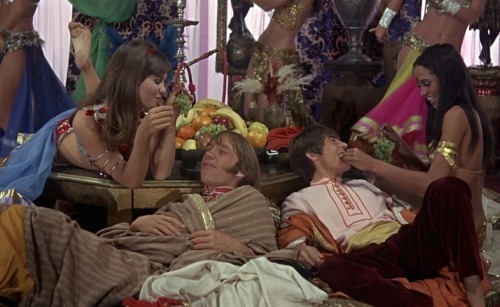

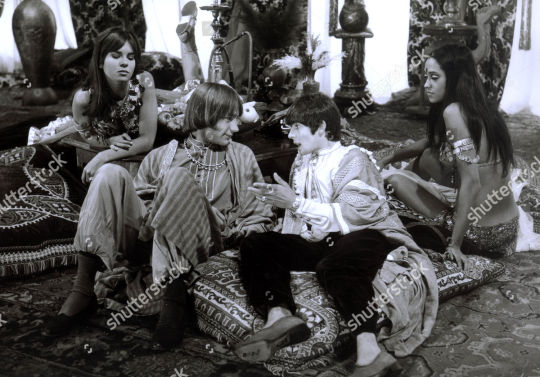

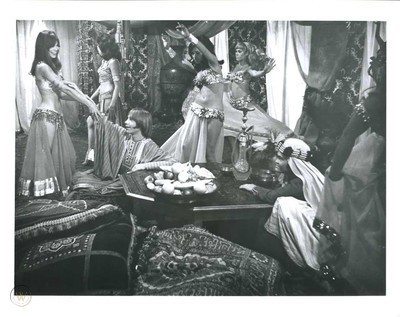



Song spotlight: “Can You Dig It?” (Tork); photos from the set of Head (1968).
"'Can You Dig It' is about the Tao. The hook line I wrote in my dressing room on the set [of the television series in 1967]. The chords for the chorus I’d written in college, and [they] had just stuck with me. I hadn’t been able to do a thing with them until I was sittin’ there, just writin’ on a scrap of paper with ideas, and I wrote, 'Can you dig it?/Do you know/Would you care to let it show?’ Those three as a triplet — as opposed to a couplet. I just looked at them and [went], 'Wow!’ I grabbed a pencil and circled those three. They were part of a quatrain. I said, ‘Wait a minute. No, this works best as a little three-line chorus.'" - Peter Tork, Head box set liner notes
"I think they’re ['Can You Dig It?’ and 'Long Title: Do I Have To Do This All Over Again?'] the best songs in the movie [Head]. I love both of them. I thought they were just terrific. He had plugged himself into that whole Stephen Stills connection and was working with those guys. I think they fit the movie better than anything did. When those two songs start up in the movie, it comes alive for me." - Michael Nesmith, Head box set liner notes
“This started as a set of changes I wrote in college and didn’t know what to do with. Then one afternoon on the set of the Monkees we were making the TV show and I had my guitar in my dressing room. The basic lyrics came to me and these changes I had stored in the back of my brain spring forth and dictated that kind of vaguely Spanish/North African harmonic sense. I was writing about the great unknown source of all. It was perfect for the Head soundtrack.” - Peter Tork, Rolling Stone, August 23, 2016
“When I recorded ‘Can You Dig It,’ the guitar solo originally ran about three or four minutes all by itself. We cut that back to a minute and a half. Bob Rafelson took a pair of scissors and snipped off the end of it. He didn’t ask me to shorten it, which I would have been glad to do. He just chopped it off. Son of a bitch! I have a lot of gripes about that, but that’s neither here nor there.” - Peter Tork, Blitz!, May/June 1980
“Dewey Martin, Buffalo Springfield’s drummer. He was also a very good drummer. I was really impressed with him. In the Monkees movie Head, ‘Long Title’ and ‘Can You Dig It,’ he’s on both of those cuts. He’s the drummer on both of those, for the most part. Actually, I think it’s ‘Can You Dig It,’ it involves a lot of playing around on the toms, and I had Dewey take the snares off of his snare to make it into another tom, and he said, ‘I can’t get the snare back on in time to play the backbeats,’ and I said, ‘Nevermind, play the backbeats on the tom and I’ll overdub the snare afterwards.’ And I overdubbed the snare myself, so that’s me playing snare. But all the running around on the toms and the rest of it, that’s Dewey.” - Peter Tork, 2007, published by Rolling Stone in 2019 (x)
"Can You Dig It?" with Peter's vocal, 1968: here.
Peter performing "Can You Dig It?" live during The Monkees' tour in 1987: here.
#Peter Tork#Davy Jones#Michael Nesmith#Micky Dolenz#Head (1968)#The Monkees#Monkees#Tork quotes#Tork songs#Can You Dig It#1960s#criminally underrated#Peter deserved better#long read#Dewey Martin#love his mind#1968#Blitz! Magazine#Rolling Stone#can you queue it
80 notes
·
View notes
Text


(x) welcome back patrick's cheekbones. they didn't go anywhere im just happy to see them
#media blitz#these are like gorgeous headshots or perhaps a shoot from a bears lifestyle magazine<3#which i suppose maybe kerrang is#emphatic slash jay#edit im also PISSED i missed his first post elliott u wanna repost the extra ones so bad. u wanna repost them so i can pull them in hq pls
372 notes
·
View notes
Text
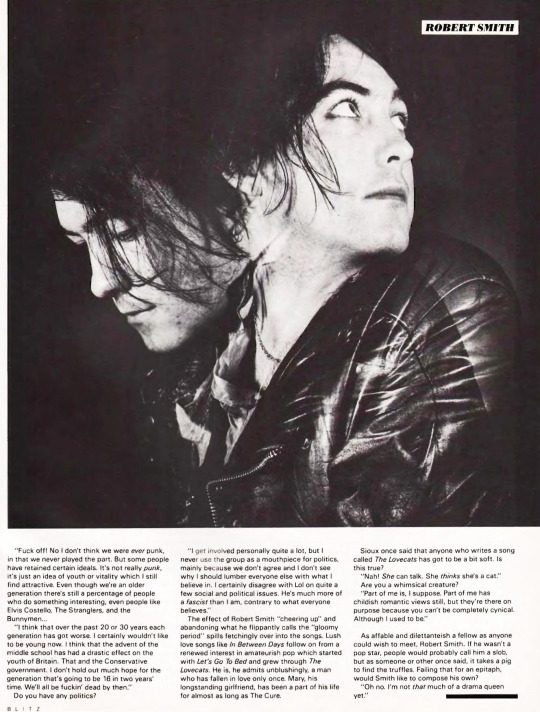
Robert Smith, ''Blitz'', #34, Sept. 1985 Source
326 notes
·
View notes
Text

Mick Jones during his B.A.D. era, here as the cover model for Blitz Magazine, June 1988 issue.
At the time Big Audio Dynamite had just released their 3rd album, 'Tighten Up, Vol. 88', featuring Paul Simonon's artwork for the cover, which may very well be the best thing about it, since the album had all the free-form elements of the previous ones, like hip hop, dance, reggae, funk and even a little country music that can be very upbeat, catchy and danceable, yet it kind of felt all over the place.
Here's some footage of Mick Jones promoting the album on MTVE and being interviewed by Tricia Ronane, former model, Paul Simonon's wife & co-manager of the Clash's royalties at the time, where Mick attempts to describe the physical effort it took to do the album struggling with his instruments and Tricia just struggles to keep from laughing at the thought of Mick 'struggling with his instrument'.
(via)
10 notes
·
View notes
Text
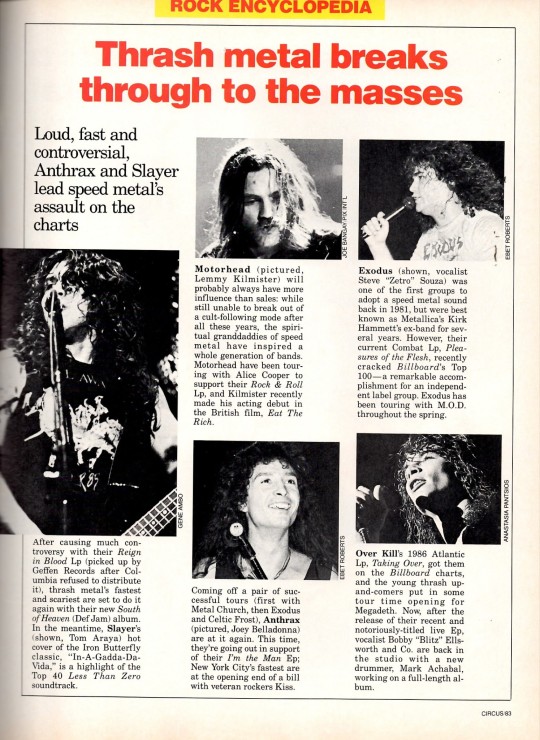
#circus#circus magazine#tom araya#slayer#lemmy kilmister#motorhead#steve souza#zetro#exodus#joey belladonna#anthrax#bobby ellsworth#blitz ellsworth#over kill
58 notes
·
View notes
Text

from Blitz magazine, issue 39, March, 1986
#i haven't seen this one here so i'll have the honor of uploading it hah#john lydon#johnny rotten#public image ltd#blitz magazine#blitz
15 notes
·
View notes
Text



Blitz Magazine 1990 Sept
7 notes
·
View notes
Text





TBT to October 1993. Gumrah was about to be released. Sridevi and Sanjay Dutt took over all the major magazine covers.
14 notes
·
View notes
Text


Saoirse Ronan covers the Best Performances Issue of W Magazine. Photographed by Mert Alas & Marcus Piggott
2 notes
·
View notes
Text


Silver Screen magazine, April 1940
#hollywood#annabella#charles boyer#1940s#1940#wwii#world war ii#world war 2#relief#blitz#1939#old hollywood#vintage hollywood#classic hollywood#silver screen#silver screen magazine#magazine#movie magazine
6 notes
·
View notes
Photo


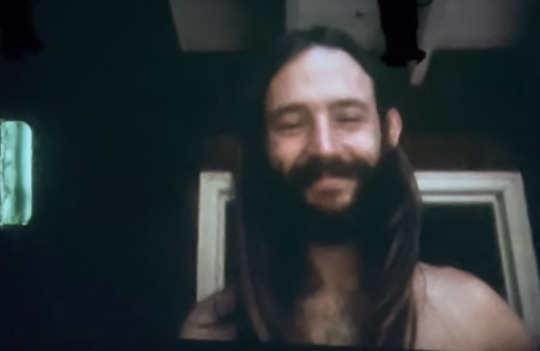
Peter Tork in screenshots from footage included in Micky Dolenz Celebrates The Monkees (x).
“To the outside observer, I’m sure it looked as though I had succumbed to the extremities of a given culture. To me, I simply exhibited moderate good sense. Basically, I lived at a poverty level, scratching for odd jobs. I wore a beard, my hair was past my shoulders, and I was working in a restaurant, singing folk songs and waiting tables [see here and here]. I was playing piano and was in and out of various rock groups. I played lead guitar for a rock group called Osciolla [sic]. No records. I was in the bass section of the Fairfax Street Choir, a thirty-five member vocal group. I also fronted a group of my own and tried to make a demo, but it didn’t go anywhere. I had a job offer to come out here to Venice. I also worked as a high school teacher [see here and here]. The mass media has a tendency to distort. As long as capitalism remains the underpinning of society, what is good will always take a back seat to what will sell. General Motors isn’t concerned with making a quality automobile. Sears isn’t concerned with offering a quality television set. All that counts in a capitalistic society is selling. And to the mass media’s way of thinking, a picture of Peter Tork as a so-called ‘burned-out hippie’ with a beard and long hair implies a hopeless case who can’t lift his hand to his face to get his razor up and who has no interest except in stealing to support his drug habit. If that’s what sells, they’ll print that. The truth of the matter is, my primary concern was and is self-realization in a social setting.” - Peter Tork, Blitz!, May/June 1980
“‘It's what I call the Church of Three,’ [Tork] said. ‘You have a starting point that's essentially unitary, then comes the binary, the secondary phase, where everything is broken up and shattered and shot into millions of pieces. From there, you must have a dialectic. The third stage must appreciate and understand and value the first without undercutting and devaluing the second. It's no good just to talk about the positive. If the negative is there, you can't shut it out. For a while there wasn't any negative. Then it came into our lives in real ways, in ways we had to come to grips with. So, there we were, in the middle of stage two, shattered and broken, not believing in stage one anymore. Then comes stage three. This is where we recognize that there are times to slip into that primary mode and times when it won't do. If you insist on sticking to that mode, you're going to get your nose broken. And that's what happened. So there comes a time when, in full awareness of stage one, you behave through stage two, to get your stage three – a transcendent involvement of both stages.’ Specifically, stage two began at Kent State, when four students were shot by the National Guard during a protest demonstration. ‘When they shot them down at Kent State, that was the end of the flower-power era,’ said Tork. ‘That was it. You throw your flowers and rocks at us, man, and we'll just pull the guns on you. Essentially, the revolution, which was sort of tolerated as long as it wasn't a significant material threat, was not tolerated anymore. And everybody went “Ooops” and scurried for cover and licked their wounds. They became isolated – which was the point of it all. “Togetherness isn't going to get it” was the moral they tried to lay on us, because the less togetherness there is, the more room there is for exploitation. Kent State was an attempt. Let's try this and see what happens. And what happened was the shooting and vast inflation and a swing to the right – the moral majority. The whole thing was inherent in the situation. A certain amount of loosening up, a certain amount of extra leisure, and people are going to try to improve their lot instead of just barely hanging on. If you had a little extra you're going to try to make everything better. And if you see that your own happiness, or the lack of it, is tied in with the sadness of your neighbor, you're going to start feeling communal. And that's going to expand until the crunch comes. As long as people are educated to believe that isolated self-interest is the only way to go, when the crunch comes they'll withdraw from each other. And only now, in the faintest glimmerings, do I see any sense that people are realizing that togetherness and flower power alone won't get it. It's got to be togetherness, flower power, plus a willingness to do something pretty stern from time to time. If you're not willing to behave sternly, people who won't stop short of stern behavior are going to keep on going. It's taken a while for that message to sink in.’ It's obvious that Tork was a true believer and ironic that he, of all people, should have been a cog in the plastic Monkee machine. He took the sixties to heart, and if the failure of the sixties took the heart out of him for a while, he hasn't let that failure break him. ‘You've got to struggle over the material,’ he said. ‘The struggle involved in keeping those people who want what you've got from getting it deprives you of the time to really be yourself. Instead of struggling to keep things out of everybody's hands, if you give what you've got – as Jesus said – if you give away what you've got, life unfolds for you. And the Catholic church would have us believe that heaven doesn't happen until after the death of the body. But I report differently. I report that heaven is an experience available in this life. And it comes from giving your shit away. If you give away your heart, your life, your soul, your goods, and live as close to the bone as you can prudently do, and don't worry about next week, if you live as close to that level as possible, you will find yourself as happy as possible. If you put your faith in the future, you're going to be chasing something all your life. Put your faith in the present; it's all right.’” - When The Music Mattered (1984)
#Peter Tork#Tork quotes#70s Tork#Fairfax Street Choir#Osceola#Release#Peter Tork and/or Release#<3#Peter deserved better#also always so much respect for Peter's unflinching honesty in interviews#Tork teaching#long read#screenshots#1970s#The Monkees#Monkees#love his mind#1970#The Great American Food and Beverage Company#Blitz! Magazine#When The Music Mattered#can you queue it
24 notes
·
View notes
Text
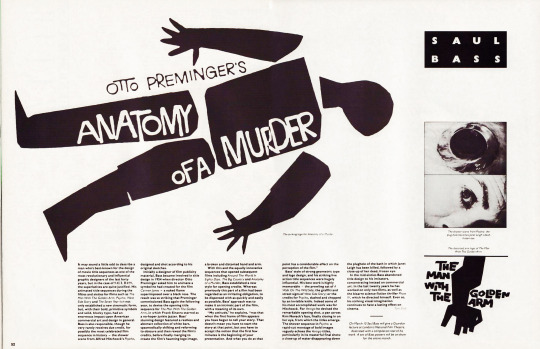
Saul Bass, ''Blitz'', #39, March 1986 Source
74 notes
·
View notes
Photo

Poster of Sweet from issue 515 of Jackie magazine, published November 17, 1973.
#Sweet#The Sweet#Andy Scott#Steve Priest#Brian Connolly#Mick Tucker#1973#posters#Jackie magazine#The Ballroom Blitz
31 notes
·
View notes
Text

2 notes
·
View notes
Text

6 notes
·
View notes
Text







Blitz 1990
2 notes
·
View notes